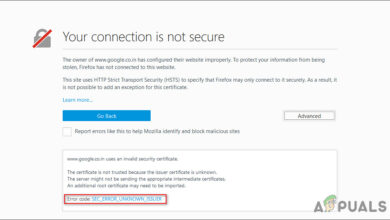How to Fix PR_END_OF_FILE_ERROR ‘Secure Connection Failed’ on Firefox
The PR_END_OF_FILE_ERROR (Secure Connection Failed) appears when some Mozilla Firefox users attempt to visit a certain website. This error essentially means that the browser wasn’t able to establish a secure connection due to the fact that all cipher suites failed (Firefox reached the end of the list due to various reasons). Whenever this happens, affected users report that the same error message occurs with every website that they try to visit.

Note: This issue different from the Secure Connection error that some users get when using Google Chrome to visit a website.
What’s causing the PR_END_OF_FILE_ERROR (Secure Connection Failed) on Firefox?
- VPN or Proxy interference – Once likely culprit that might cause this issue is a proxy or VPN interference. Any software that is intercepting the connection (acting as a middle man) has the potential of triggering this particular error message. If this scenario is applicable, you can fix the issue by disabling the proxy server or by uninstalling the VPN application that is protecting your anonymity.
- Incorrect cipher variants – If you previously went ahead and modified SSL settings, it’s likely that you’re seeing this error due to the fact that your browser is now enforcing some cipher variants that aren’t supported by Firefox or by the website that you’re trying to access. To fix this problem, you need to refresh your Firefox browser via the Troubleshooting Information menu.
- Corrupted Firefox profile – As it turns out, this error code can also be caused by a corrupted profile. Several affected users have been able to fix the issue by exporting their bookmarks, creating a new profile and then importing the bookmarks from their old profile in order to prevent any data loss.
- 3rd party security suite interference – It’s been confirmed that there are also some overprotective 3rd party suites that will cause this problem (Avast, Kaspersky, BitDefender, Eset) that will cause this problem after intercepting connection certificates and sending their own. In this case, you can work around the issue either by disabling the real-time protection or by uninstalling the overprotective suite altogether.
Steps to Fix the PR_END_OF_FILE_ERROR ‘Secure Connection Failed’ Error
1. Disable VPN or Proxy Connection (if applicable)
As several affected users have reported, the PR_END_OF_FILE_ERROR (Secure Connection Failed) can occur in situations where the affected users are using a proxy or VPN server (or any other kind of software that works by intercepting the connection and acting as the middle man).
It turns out that some solutions work, but others might end up producing this particular error as long as they are enabled. If you are using a VPN or proxy solution, it’s probably the reason why you are seeing this error message.
If this scenario is applicable, try to fix the problem by connecting directly after disabling the software that is protecting your anonymity. To make this process as easy as possible, we created two separate guides – one for proxy users and one for users that are using a VPN client. Feel free to follow whichever method is applicable to your particular scenario.
Removing the VPN Client
- Press Windows key + R to open up a Run dialog box. Once you’re inside, type ‘appwiz.cpl’ inside the text box and press Enter to open up the Programs and Features menu. Once you see the User Account Control (UAC) prompt, click on Yes to grant administrative privileges.

Type appwiz.cpl and Press Enter to Open Installed Programs List - Once you are inside the Programs and Features screen, scroll through the list of installed software and be on the lookout for the 3rd party VPN that you’re currently using. Once you see it, right-click on it and choose Uninstall from the newly appeared context menu.

Uninstalling a VPN tool - Once you’re inside the uninstallation wizard, follow the on-screen instructions to complete the uninstallation process. After the operation is complete, do a computer restart and see if the issue is resolved at the next system startup.
Disabling Proxy Server
- Open up a Run dialog box by pressing Windows key + R. Next, once you’re inside the text box, type ”ms-settings:network-proxy’ and press Enter to open up the Proxy tab of the Settings app.

Run dialog: ms-settings:network-proxy - Once you manage to land inside the Proxy tab, scroll down to the Manual proxy setup section. Then, move over to the right-hand section and disable the toggle associated with Use a proxy server.
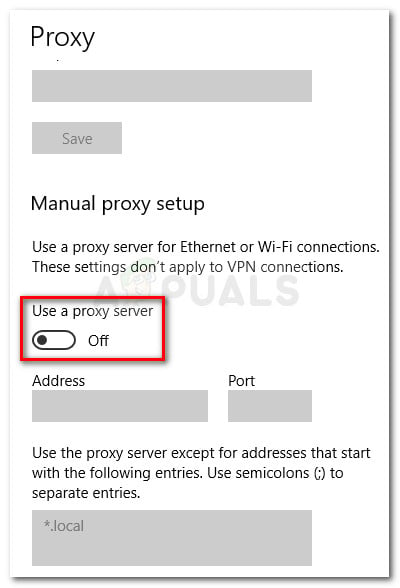
- Once the operation is complete, restart your computer. Once the next startup is complete, repeat the action that was previously causing the PR_END_OF_FILE_ERROR (Secure Connection Failed) error.
If the same issue is still occurring after following the instructions below or none of the two methods were applicable to your current situation, move down to the next potential fix below.
2. Refresh Firefox browser
As it turns out, this particular error is quite common in situations where the affected users have previously played around with some SSL settings that ended up enforcing some cipher variants that are not supported by Firefox or by the website that you are trying to access.
If the above scenario is applicable, the only viable fix is to reset your Firefox settings to the default state. Fortunately, this browser includes an option that will allow you to do this without having to reinstall the program altogether.
Here’s a quick guide on refreshing the Firefox browser via the Troubleshooting Information menu:
- Open up your Firefox browser and click on the action button in the top-right section of the screen. Next, from the list of available options, click on Help > Troubleshooting Information.

Accessing the Troubleshooting Information menu in Firefox - Once you’re inside the Troubleshooting Information menu, go to the right-hand side section and click on Refresh Firefox (under Give Firefox a tune-up).
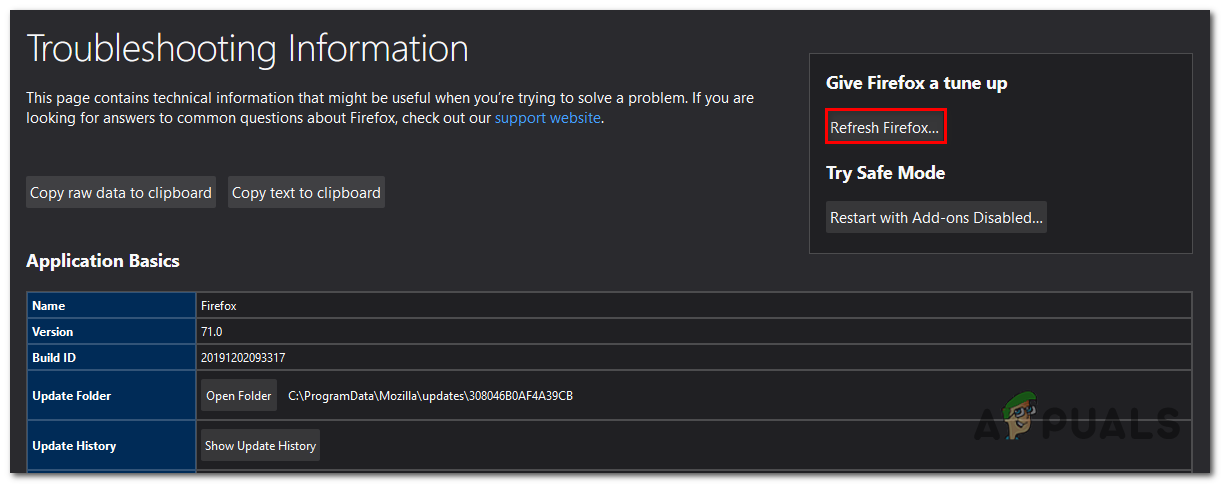
Giving Firefox a tuneup via the Refresh Firefox feature - At the final confirmation prompt, click on Refresh Firefox once again to start the process. Then wait patiently until the process is complete before restarting the browser.

Refreshing Firefox - Repeat the action that was previously causing the problem and see if the same issue is still occurring.
If the same PR_END_OF_FILE_ERROR (Secure Connection Failed) error is still occurring after you followed the instructions above, move down to the next potential fix below.
3. Disabling DNS over HTTPS option
There is an option in Mozilla Firefox that you can use to enhance your security, however, this can cause some websites to don’t work at all and give you PR_END_OF_FILE_ERROR (Secure Connection Failed) error. You can easily fix this issue. Follow these steps:-
- Open Firefox and type this in the address bar: “about:preferences#general” then press enter.
- Now scroll all the way down and click the “Settings” option in front of Network Settings.
- Now uncheck the “DNS over HTTPS option” and restart your Firefox.
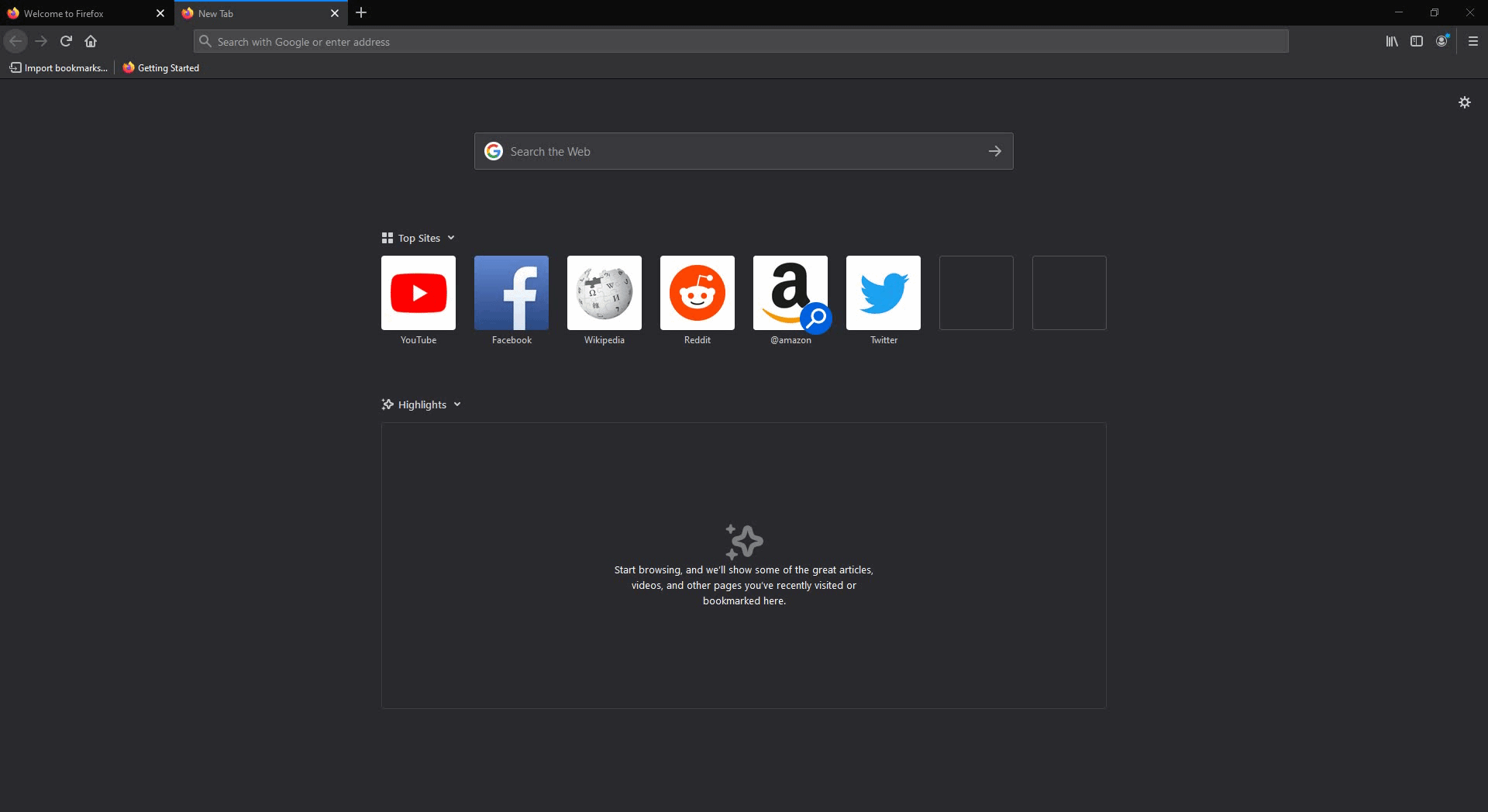
Disabling DNS Over HTTPS
4. Creating a New Firefox Profile
As it turns out, the PR_END_OF_FILE_ERROR (Secure Connection Failed) error can also be caused by a corrupted profile. Several affected users have confirmed that the issue was resolved after they created a new fresh profile via the ‘about:profiles’ tab and then exporting the bookmarks from the old profile and importing them into the new one.
Note: If most of your bookmarks are on Chrome, you can easily import them into Firefox.
This operation sounds like a mouthful, but the steps are actually very straightforward. Here’s what you need to fix the issue if it’s being caused by a corrupted profile:
- First things first, let’s start by exporting your bookmarks so you can safely use them on your new profile. To do this, click on the bookmark icon (top-right corner) then go to Bookmark > Show All Bookmarks.

Accessing the Bookmarks window in Firefox - Once you’re inside the Library menu, click on the Import and Backup menu and select Export Backups to HTML from the list of available options.
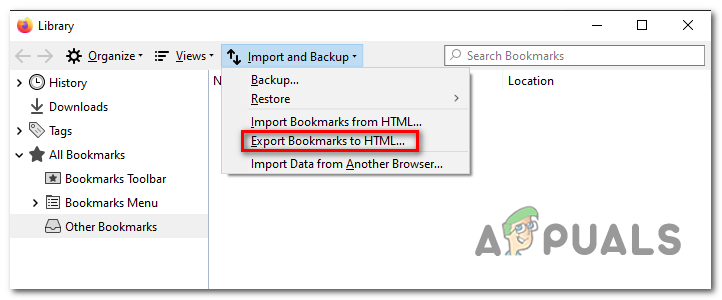
Exporting Bookmarks to HTML in Firefox - Decide on an appropriate location, then assign a name and click on Save to export your personal selection of bookmarks.
- Open your Firefox browser and go to the navigation bar at the top. Once you’re there, paste ‘about:profiles’ and then press Enter to open up the Profile section of Firefox.

Accessing the Profiles section of Firefox - Once you’re inside the correct menu, click on Create a New Profile (under About Profiles).

Creating a New profile in Mozilla Firefox - Once you’re inside the first screen of Create Profile Wizard, click on Next to advance to the next menu. At the next screen, assign a name for your profile (under Enter new profile name) and click Finish to generate the new profile.

Creating the New Mozilla Firefox profile - After you create the new profile, it’s time to recover the bookmarks from your old profile. To do this, click on the bookmark icon (top-right corner) then go to Bookmark > Show All Bookmarks.

Accessing the Bookmarks window in Firefox - Inside the Library menu, click on Import and Backup > Import Bookmarks to HTML. Next, from the next menu, navigate to the location where you previously saved the exported bookmarks (at step 3) and click Open to import them into the new profile.

Importing bookmarks - Restart your browser and see if the PR_END_OF_FILE_ERROR (Secure Connection Failed) error has stopped occurring.
If the same problem is still occurring, move down to the next method below.
5. Uninstall 3rd party security suite
As it turns out, this particular issue can also occur due to an overprotective 3rd party AV (security suite). This happens due to the fact that some security tools like Avast, Kaspersky, BitDefender, ESET (and others) are designed to intercept connection certificates and send their own.
While the vast majority of websites have nothing against this, some might end up triggering the PR_END_OF_FILE_ERROR (Secure Connection Failed) error as a security precaution.
If this scenario is applicable, you can get the problem resolved by disabling the real-time protection while accessing the website or by uninstalling the overprotective security suite.
The damage-controlled approach is to disable the real-time protection. But keep in mind that this procedure will be different depending on which 3rd party tool you’re using. Fortunately, in most cases, you will be able to do it directly from the taskbar icon of your antivirus or your firewall suite.

After you do this, restart your computer and see if the same issue is still occurring.
If the problem persists, the next logical step would be to completely eliminate the possibility of 3rd party security interference. Here’s a quick guide on how to do this and ensure that you’re not leaving behind any leftover files that might still cause the same time of behavior:
- Press Windows key + R to open up a Run dialog box. Next, type ‘appwiz.cpl’ and press Enter to open up the Programs and Features window.

Type appwiz.cpl and Press Enter to Open Installed Programs List - Once you’re inside the Programs and Features screen, scroll through the list of installed applications and locate the 3rd party security suite that you’re currently using. After you manage to locate it, right-click on it and choose Uninstall from the newly appeared context menu.

Uninstalling Antivirus Using Control Panel - Inside the uninstallation menu, follow the on-screen instructions to complete the uninstallation.
- After the uninstallation is complete, follow the instructions on uninstalling every leftover file from your security suite.
- Restart your computer and see if the issue is resolved at the next computer startup.



